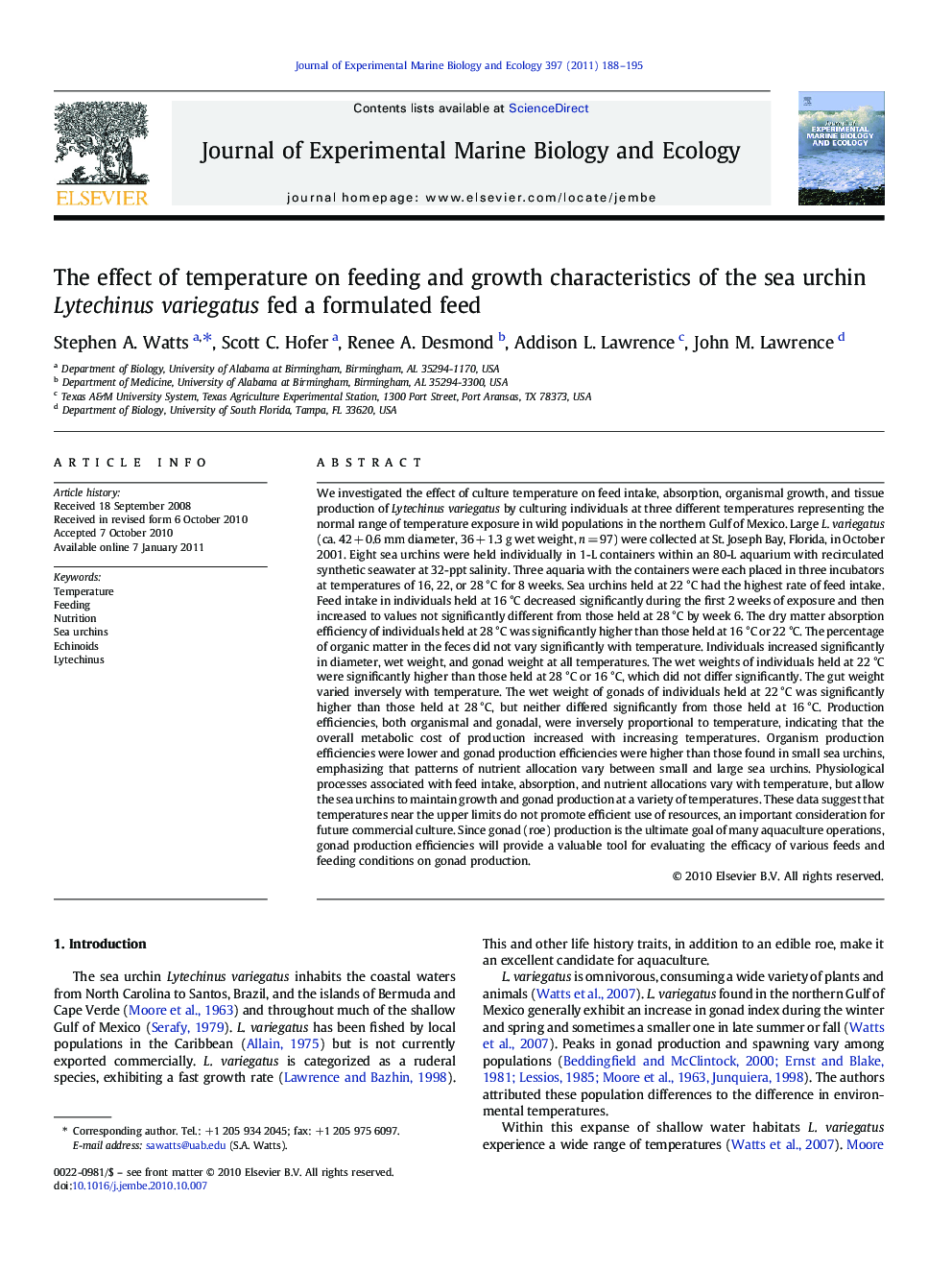| کد مقاله | کد نشریه | سال انتشار | مقاله انگلیسی | نسخه تمام متن |
|---|---|---|---|---|
| 4396378 | 1305818 | 2011 | 8 صفحه PDF | دانلود رایگان |

We investigated the effect of culture temperature on feed intake, absorption, organismal growth, and tissue production of Lytechinus variegatus by culturing individuals at three different temperatures representing the normal range of temperature exposure in wild populations in the northern Gulf of Mexico. Large L. variegatus (ca. 42 + 0.6 mm diameter, 36 + 1.3 g wet weight, n = 97) were collected at St. Joseph Bay, Florida, in October 2001. Eight sea urchins were held individually in 1-L containers within an 80-L aquarium with recirculated synthetic seawater at 32-ppt salinity. Three aquaria with the containers were each placed in three incubators at temperatures of 16, 22, or 28 °C for 8 weeks. Sea urchins held at 22 °C had the highest rate of feed intake. Feed intake in individuals held at 16 °C decreased significantly during the first 2 weeks of exposure and then increased to values not significantly different from those held at 28 °C by week 6. The dry matter absorption efficiency of individuals held at 28 °C was significantly higher than those held at 16 °C or 22 °C. The percentage of organic matter in the feces did not vary significantly with temperature. Individuals increased significantly in diameter, wet weight, and gonad weight at all temperatures. The wet weights of individuals held at 22 °C were significantly higher than those held at 28 °C or 16 °C, which did not differ significantly. The gut weight varied inversely with temperature. The wet weight of gonads of individuals held at 22 °C was significantly higher than those held at 28 °C, but neither differed significantly from those held at 16 °C. Production efficiencies, both organismal and gonadal, were inversely proportional to temperature, indicating that the overall metabolic cost of production increased with increasing temperatures. Organism production efficiencies were lower and gonad production efficiencies were higher than those found in small sea urchins, emphasizing that patterns of nutrient allocation vary between small and large sea urchins. Physiological processes associated with feed intake, absorption, and nutrient allocations vary with temperature, but allow the sea urchins to maintain growth and gonad production at a variety of temperatures. These data suggest that temperatures near the upper limits do not promote efficient use of resources, an important consideration for future commercial culture. Since gonad (roe) production is the ultimate goal of many aquaculture operations, gonad production efficiencies will provide a valuable tool for evaluating the efficacy of various feeds and feeding conditions on gonad production.
Research Highlights
► Physiological processes associated with feed intake and absorption vary with temperature.
► Sea urchins can maintain growth and gonad production at a variety of temperatures.
► Temperatures near the upper limits do not promote efficient use of resources.
► Gonad production efficiencies are a valuable tool for evaluating feeds.
Journal: Journal of Experimental Marine Biology and Ecology - Volume 397, Issue 2, 15 February 2011, Pages 188–195